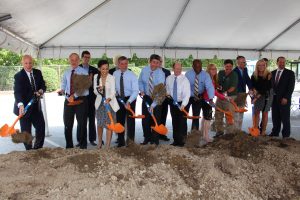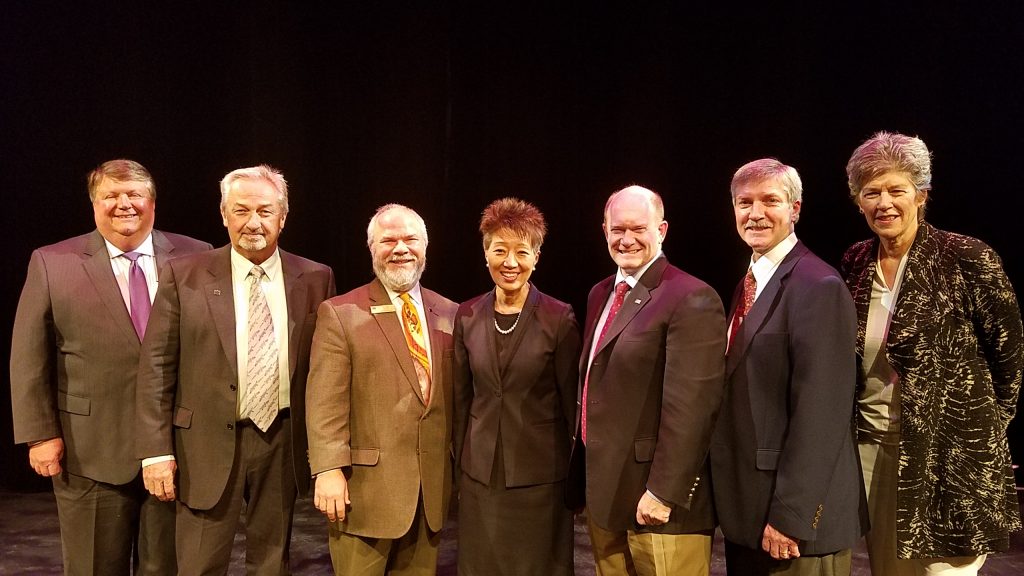Governor John Carney and the Delaware congressional delegation gathered at the Rose Hill Community Center in New Castle today to announce a $6 million federal grant from the Rebuilding American Infrastructure with Sustainability and Equity (RAISE) program to help urban and rural communities move forward on projects that modernize roads, bridges, transit, rail, ports, and intermodal transportation and make our transportation systems safer, more accessible, more affordable, and more sustainable.
“This announcement is about building a stronger community. More than a quarter of the residents in the Route 9 area do not have access to a car and rely on walking, biking, and public transportation,” said Governor Carney. “This $6 million award from the Rebuilding American Infrastructure with Sustainability and Equity program will help make Route 9 safer and livable for pedestrians. Thank you to the Congressional delegation – Senators Carper and Coons and Representative Blunt Rochester – for advocating tirelessly for the Bipartisan Infrastructure Law that is driving this project.”
Secretary of Transportation Nicole Majeski added, “We are looking at our road systems through a new lens and not just how we are moving automotive traffic, but all modes of transportation. Everyone deserves an equitable right to mobility and these projects will help residents of these communities travel safer and easier whether its walking, biking, using public transportation, or an automobile.”
“We are seeing our hard work on the Bipartisan Infrastructure Law in the Environment and Public Works Committee come to fruition, right here on Route 9,” said U.S. Senator Tom Carper, chair of the committee. “The federal funding that will help uplift the Route 9 corridor that we are celebrating today is from the RAISE Grant program, which aims to make investments in safety, especially for pedestrians and bicyclists, sustainability, and resilience, all while addressing the backlog of repairs in our nation’s transportation system. I look forward to seeing the results of this remarkable investment into these communities.”
“When the Route 9 corridor was first laid out after WWII, it was too much, too close together: industrial right next to commercial, right next to residential. We have a once-in-a-lifetime chance to fix some of the things that made the roads unsafe, that made public transportation difficult to access, and that has too often made the corridor a hard place to live,” U.S. Senator Chris Coons said. “What a blessing to look back at areas where planning frankly failed the needs of the community and know we’re investing millions of dollars in federal and state funding to do real planning and produce a new vision for how people will move up and down the corridor, and how they will connect with it.”
“Investing in our transportation infrastructure is essential to the health, economy, and well-being of the First State,” said Rep. Blunt Rochester. “Today’s $6 million RAISE grant announcement will pave the way for DelDOT to begin planning on projects to improve transportation infrastructure that keep environmental, economic, and transportation equity at the forefront. I’m proud to have supported DelDOT’s grant application and to have voted for the historic Bipartisan Infrastructure Law which more than doubled funding for the RAISE Grant. There’s more work to be done but I am confident that if we — the Biden Administration, federal, state, and local leaders and community members — continue to work together, we will create safer, healthier communities here in Delaware.”
The Delaware Transit Corporation (DTC) is also receiving $630,000 in federal funding for its Connecting Route 9 Corridor Communities project, which will improve transportation in the Delaware State Route 9 corridor. Many residents in this area are members of minority groups and live below the poverty line with limited or no access to a car. With community outreach and technical analyses, DTC will plan improvements to enhance bus service, microtransit and the pedestrian environment to provide access to jobs, schools, healthcare, and other services.
The grant will fund preconstruction activities for the 12 projects identified in the 2017 WILMAPCO Route 9 Corridor Land Use and Transportation Plan and includes surveying, establishing the existing right-of-way, and location of existing utilities along the Route 9 corridor between Wilmington and New Castle to develop more detailed concept plans that address both community impact and constructability.
Construction is currently estimated to begin in 2025 on the first set of projects.

 NATIONAL ENDOWMENT FOR THE ARTS CHAIRMAN JANE CHU
NATIONAL ENDOWMENT FOR THE ARTS CHAIRMAN JANE CHU 